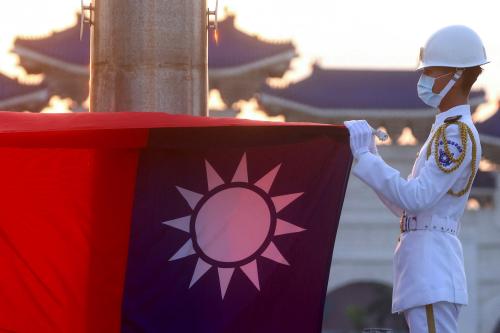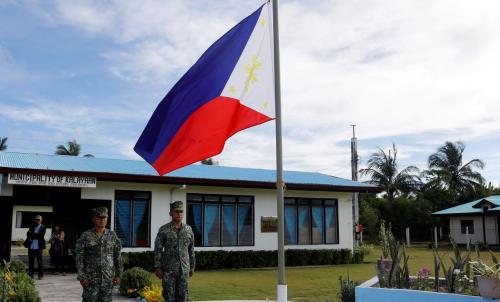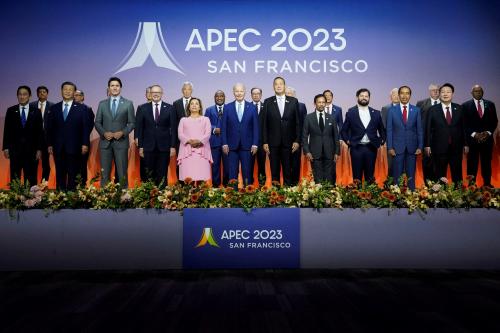In the early 1950s, the United States established a series of bilateral security alliances in Asia with the goal of deterring communist aggression and expansion in Asia. In contrast to the collective defense arrangement established through the North Atlantic Treaty Organization (NATO) in Europe, the United States established a “hub-and-spokes” alliance system that included signing treaty alliances with the Philippines (1951); Japan (1951, revised in 1960); Australia and New Zealand (1951); South Korea (1953); and the Republic of China or Taiwan (1954, ending in 1979). The network of U.S. alliances remains an enduring feature of Asia’s security landscape today. However, Asia’s regional architecture has evolved considerably since the end of the Cold War to respond to new challenges including China’s rise, North Korea’s nuclear threat, and maritime disputes in the East and South China Seas.
During the past three-and-a-half years, U.S. alliances and partnerships (i.e., security relations established without a mutual defense treaty) in Asia have experienced a renewal characterized by strengthened bilateral ties, new or revitalized mini-laterals (groupings with three or four partners), and expanded cross-regional networks including cooperation between NATO and the “Indo-Pacific Four” (Japan, South Korea, Australia, and New Zealand). In response to geopolitical shifts and to some degree domestic leadership change in Asia, the Biden administration played a significant role in strengthening U.S. alliances and cultivating Asia’s evolving regional architecture.
Nevertheless, it remains unclear how or even whether future U.S. administrations will continue to manage the existing “latticework” of bilateral, trilateral, mini-lateral, and multilateral institutions should geostrategic competition within and outside of Asia continue to intensify. On this front, the 2024 U.S. presidential election may carry significant consequences for U.S. alliances in Asia. How and to what degree Donald Trump and Kamala Harris, the respective Republican and Democratic nominees, decide to lead, manage, and/or engage or disengage with Asian allies and partners will also have an important bearing on regional stability and order for the foreseeable future.
Assessing U.S. alliances, partnerships, and regional developments in Asia
To better understand U.S. alliances in Asia and what is at stake in the upcoming 2024 presidential elections, a team of scholars affiliated with Brookings’ Center for Asia Policy Studies has assessed the current state of several U.S. alliances and partnerships and their relevance to U.S. interests in the region. Contributions include U.S. relations with Australia, Japan, South Korea, the Philippines, Taiwan, India, and the Association of Southeast Asian Nations (ASEAN).
Authors contributing to this series were provided the following questions to consider in their analysis:
- How does a particular U.S. ally/partner add value to U.S. interests in the Indo-Pacific and/or contribute to regional security and stability?
- How does the ally/partner perceive its security environment and the role its alliance/partnership with the United States plays in addressing its security concerns?
- What recent security commitments or agreements has the United States made to the U.S. ally/partner and vice versa?
- What basing and access agreements does the United States enjoy and are U.S. allies/partners sufficiently contributing to the relationship?
- What are some specific political dynamics to watch for in the run-up to elections, and what steps would you recommend for the next administration?
The questions were offered to provide some degree of structure across commentaries. However, contributors were free to expound on any issue or additional themes deemed relevant to a given bilateral relationship or U.S. policy in Asia. There was no expectation to conform to a particular policy position.
Two other developing issues closely related to Asian alliances—economic statecraft and linkages between U.S. partners in Asia and Europe—are also addressed in this series given their priority in both political parties’ foreign policy messaging. Economic statecraft includes thinking about not only the fate of the Biden administration’s Indo-Pacific Economic Framework, but also the role of tariffs and export controls, the increasing weaponization of economic interdependence, and these tools’ implications for the broader regional and global economic order.
Meanwhile, the war in Ukraine and increasing concerns regarding a Taiwan Strait conflict have accelerated the pace of cooperation between NATO and U.S. allies in Asia. U.S. allies favoring engagement with like-minded democracies in a rules-based liberal international order have welcomed this development, but the pace and quality of cross-regional alliance cooperation may also be contingent on the outcome of the 2024 elections.
Three broad takeaways emerge from the nine commentaries in this series. First, U.S. alliances and partnerships remain resilient to internal and external challenges but will benefit from deeper cooperation and institutionalization. Second, U.S. allies express greater uncertainty about their alliances with the United States if Trump, rather than Harris, wins the 2024 election. Third, nevertheless, there may be a greater convergence of views on the Indo-Pacific between the presidential candidates than is recognized.
The case for alliance continuity in Asia
The United States has made great strides in enhancing alliances and partnerships in recent years, helping pave the way for a shift from a hub-and-spokes system to a more networked regional security architecture. The renewal of alliances has been aided by several regional and domestic factors. Shifts in the regional security environment, including China’s assertiveness over maritime and land disputes, North Korea’s ties to Russia and its expanded weapons capabilities, and greater challenges to economic security—including increased supply chain vulnerability—have persuaded U.S. partners old and new to deepen their cooperation with the United States. Regional threats have also paved the way for new mini-laterals and strengthened intra-alliance networks such as the trilateral security partnership between Australia, the U.K. and the United States (AUKUS), the U.S.-Japan-South Korea trilateral, and the Australia-India-Japan-U.S. Quad, as noted by Bruce Jones, Adam Liff, and Tanvi Madan in their respective pieces.
New leadership in some Asian capitals such as Seoul and Manila favoring U.S. bilateral relations have also created positive synergies within the alliance network. Nowhere has this shift been more dramatic than in the Philippines, as Lynn Kuok argues in her contribution on the U.S.-Philippines alliance. The transition from President Rodrigo Duterte to Ferdinand Marcos Jr. in 2022 allowed for increased U.S. basing access and greater coordination in confronting Chinese aggression in the South China Sea.
The long pivot to Asia, launched during the Obama administration and pursued by the Trump administration through its Free and Open Indo-Pacific Strategy, made further strides under President Joe Biden’s watch. As suggested by several contributors, the next U.S. administration will need to institutionalize the latticework of overlapping institutions that have emerged in recent years.
Greater uncertainty under Trump than Harris
Given Trump’s past statement on alliances, it should come as no surprise that several contributors find more uncertainty in a future Trump than Harris administration on alliance issues. For instance, on U.S.-South Korea relations, Evans Revere contends that a Trump victory may elicit “renewed questioning of the alliance and attacks on Seoul’s defense contributions.” On U.S. ties to Taiwan, Richard Bush notes “contradictory tendencies” and “rhetorical inconsistency” during the first Trump administration which might repeat if Trump is reelected. Tara Varma asserts that Trump may pressure allies with new demands including increased defense burden-sharing contributions, and in doing so pit European and Asian allies against each other. On regional economic ties, Mireya Solís highlights Trump’s threat to increase tariffs against allies and adversaries alike.
Although some observers who are fearful of a Trump win may be bracing for the worst, Bush provides a useful reminder that any predictions at best remain speculative, at least until 2025. As Bush, Madan, and others assess, who holds key positions in the next administration and how power and decisionmaking are organized will also shape the direction of policy. There will likely be more changes and uncertainty to U.S. policies in the Indo-Pacific under a potential Trump than Harris administration by virtue of a change in government. However, U.S. alliances and regional partnerships may experience more continuity than presumed depending on which set of advisers has Trump’s ear on foreign policy.
Greater convergence of views in the Indo-Pacific
Finally, deepening turmoil and political polarization in U.S. politics belie the degree of convergence between the two parties when it comes to the next administration’s approach to China and thus the need for a U.S. presence in the Indo-Pacific. Indeed, it may be difficult for either Harris or Trump to develop a meaningful U.S. strategy in Asia without drawing support from U.S. allies and partners, especially given bipartisan concerns over China’s regional assertiveness. Although Trump’s disparaging statements about alliances may be concerning, most Republicans take the China challenge seriously and look to the Indo-Pacific as a region of vital U.S. interest.
A key takeaway is for the next U.S. president to articulate the United States’ vital interests in the Indo-Pacific region to the American public and to build a strong case for continued engagement. Sustaining alliances and partnerships is a crucial element of this engagement. For example, Adam Liff points to the U.S.-Japan alliance, including the 50,000 U.S. troops stationed in Japan and the increasing interoperability between the U.S. military and the Japan Self-Defense Forces as a “potent force multiplier for U.S. foreign policy objectives in a region” and an “extraordinary bargain.” Similarly, Bruce Jones identifies a broad consensus in the United States about “the need to rapidly reinforce defense capabilities vis-à-vis China.” Cost-sharing initiatives with allies such as AUKUS evidently advance this objective.
Cultivating relations with Asian partners
Assuming that there is a continued role for U.S. allies, partners, and coalitions in the next administration’s Indo-Pacific strategy, the United States will need to manage and cultivate these relationships. Effective leadership will require the next administration to listen to the needs of its regional allies and partners and not just push Washington’s preferences and agenda onto them.
In this regard, the United States’ economic agenda in Asia appears flat. To stay ahead of the geo-economic curve, the next administration will need to read the demand signals coming from Asia. According to Solís, this may entail providing improved market access to the United States in exchange for adherence to trade and environmental standards, or carefully calibrating the means and desired end goals of economic statecraft aimed at curbing Chinese technology advancement. Natalie Sambhi also emphasizes observations from Southeast Asia and U.S. engagement with ASEAN members, calling on the next administration to avoid treating the region as a battleground for U.S.-China competition, which may push ASEAN members further away from Washington as U.S. influence declines in Southeast Asia.
How the next administration manages or resolves differences with its allies and partners in Asia remains crucial. In that vein, the next administration should evaluate what has or has not worked, and what could be done better or differently regarding its alliances, partnerships, and coalitions. Although the Biden administration has deepened and widened U.S. ties to Asia, it is up to the next administration to take these relationships further.





Commentary
Cultivating America’s alliances and partners in the Indo-Pacific
September 16, 2024